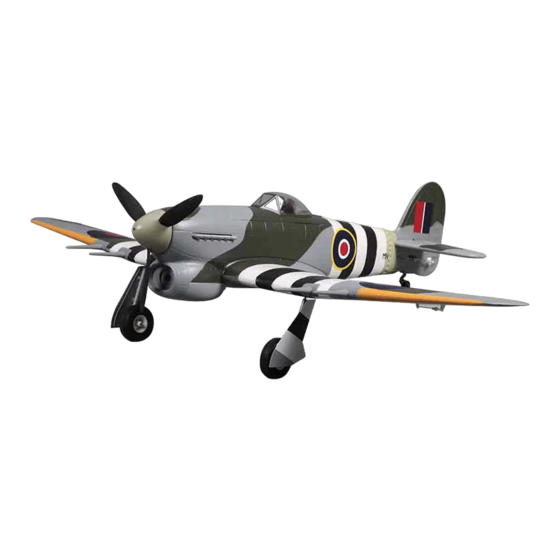
Summary of Contents for FMS FMS086P
- Page 1 1100MM Typhoon FMSMODEL.COM REALISTIC RIGID STABLE RETRACT & FLAPS INSTALLED STRONG DURABLE EPO SMOOTH FLYING PERFORMANCE...
-
Page 4: Table Of Contents
Second World War's most successful ground-attack aircraft. Take to the skies with one of FMS’s latest offerings, the Hawker Typhoon 1100mm PNP! This scale 1100mm wingspan warbid is a sight to behold. Reinforce wing surfaces allow flyers to perform advanced maneuvers like point rolls, barrel rolls, Immelmanns, half-Cubans, and split S with ease. -
Page 5: Contents Of Kit
Wingspan: 1100mm/43.3in Overall Length: 845mm/33.3 in Flying Weight: Around 1300g(45.9oz) Motor Size: Brushless 3536-KV850 Wing Load: 66.0 g/dm² (0.15oz/in²) Wing Area: 19.7dm²(305.4 sq.in) ESC: 40A Servo: 9g Servo x 6 Contents of Kit Before assembly, please inspect the contents of the kit. The photo below details the contents of the kit and labels. - Page 6 Horizontal Tail Installation 1. Slide the horizontal tail into the slot in the rear of the fuselage. Ensure the control horn face down. fig1 2. Secure the horizontal tail piece in place using the include screw: PA2.6*10. Use caution to avoid over-tightening the screw.
- Page 7 3. Using your radio center, the elevator servo and attach the control arm to the servo then attach the clevis to the elevator control horn. See instruction for clevis connection on page 11. fig3...
- Page 8 4. Install the wing a. Remove the canopy hatch b. Guide the Multi Connector wires through the hole located in the bottom of the fuselage as shown. c. Align the wing with the fuselage and secure into position using screws HKM3.0*40mm as shown in fig5 fig4 HKM3.0*40 fig5...
-
Page 9: Install The Battery And Radio Installation
Install the battery and Radio installation 1. Apply the hook tape to the cable end of the battery (fig 6). 2. Make sure the battery is secured using the hook. Note: you may need to relocate the battery position to achieve the correct CG for your model. -
Page 10: Get Your Model Ready To Fly
Get your model ready to fly Important ESC and model information The ESC included with the model has a safe start. If the motor battery is connected to the ESC and the throttle stick is not in the low throttle or position, the motor will not start until the throttle stick is moved to the low throttle or off position. -
Page 11: Check The Control Throws
Check the control throws The suggested control throw setting for FMS MODEL are as follows (dual rate setting): Tips: At first flight, fly the model in low rate. The first time you use high rates, be sure to fly at low to medium speeds. -
Page 12: Clevis Installation
Clevis Installation a. Pull the tube from the clevis to the linkage. b. Carefully spread the clevis, then insert the clevis pin into the desired hole in the control horn. c. Move the tube to hold the clevis on the control horn. Control Horn and Servo Arm Settings The table shows the factory settings for the control horns and servo arms. -
Page 13: Install The Propeller And Spinner
Install the propeller and spinner Assemble the spinner and propeller as shown below. Check the C.G. (Center of Gravity) When balancing your model, adjust the motor battery as necessary so the model is level or slightly nose down. This is the correct balance point for your model. After the first flights, the CG position can be adjusted for your personal preference. -
Page 14: Before Flying The Model
Before flying the model Find a suitable flying site Find a flying site clear of buildings, trees, power lines and other obstructions. Until you know how much area will be required and have mastered flying your plane in confined spaces, choose a site which is at least the size of two to three football fields - a flying field specifically for R/C planes is best. -
Page 15: Flying Course
Flying course Take off While applying power, slowly steer to keep the model straight. the model should accelerate quickly. As the model gains flight speed you will want to climb at a steady and even rate. Typhoon will climb out at a nice angle of attack (AOA). -
Page 16: Troubleshooting
Troubleshooting... -
Page 17: Spare Parts List Content
Spare parts list content Fuselage FMSPO101 FMSPO102 Main Wing Set FMSPO103 Horizontal Stabilizer FMSPO104 Cockpit FMSPO105 Spinner FMSPO106 Cannon FMSPO107 Main Landing Gear Set FMSPO108 Main Landing Gear System FMSPO109 Rear Landing Gear Set FMSPO110 Linkage Rod FMSPO111 Screw Set FMSPO112 Pipe FMSPO113... -
Page 18: Esc Instruction
ESC instruction...
















Need help?
Do you have a question about the FMS086P and is the answer not in the manual?
Questions and answers